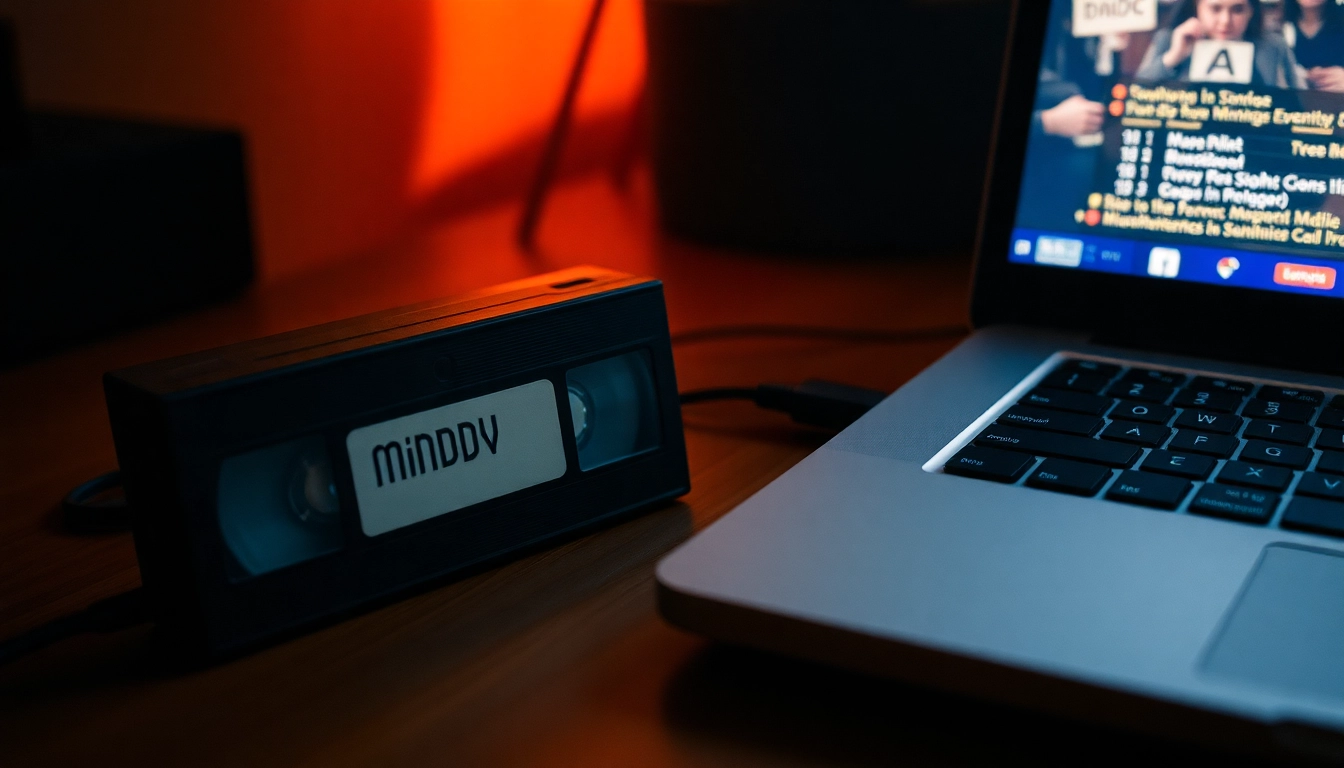Understanding MiniDV Tapes and Their Importance
What is MiniDV Format?
MiniDV is a digital video format that gained popularity in the late 1990s and early 2000s, primarily used in camcorders for consumer and semi-professional video recording. This compact tape format offered high-quality video and audio recording capabilities, capturing video at a resolution of 720×480 pixels, which was a significant technological advancement at the time. The MiniDV format employs digital compression, allowing for the storage of up to 60 minutes of footage on a single tape, all while maintaining exceptional audiovisual quality.
The Legacy of MiniDV Tapes in Video Recording
As technology evolved, MiniDV tapes became a staple in household video recording, serving as a bridge between analog and digital video recording methods. Celebrated for their reliability and portability, many families documented precious memories using MiniDV camcorders. The format enabled budding videographers and hobbyists to create everything from family films to student projects, establishing a legacy in the world of video production. However, with the advent of more sophisticated digital formats, such as HD and 4K video, the use of MiniDV tapes has significantly declined, leaving countless tapes filled with memories in need of preservation.
Benefits of Converting MiniDV to Digital Formats
The transition from MiniDV to digital formats is not merely a matter of technological upgrade; it provides numerous benefits. Firstly, digital formats offer greater longevity compared to physical tapes that may degrade over time due to wear and environmental factors. Secondly, digital files are easier to store, backup, and share, making it possible to revisit and reminisce over fond memories anytime, anywhere. Furthermore, with conversion, you gain the advantage of editing capabilities. You can assemble and enhance your videos, incorporating audio, text, and visual effects for a more polished presentation. For those interested, consider exploring Minidv to digital services to initiate this transformation.
Step-by-Step Guide to Convert MiniDV to Digital
Equipment Needed for MiniDV to Digital Conversion
Converting MiniDV tapes to digital formats requires specific equipment to ensure a smooth transition. Essential items include:
- MiniDV Camcorder or Player: You will need a working MiniDV camcorder or a dedicated player that can read the tapes. Ensure that the device you are using is in good working condition to avoid playback issues.
- Video Capture Device: This essential tool connects your camcorder to a computer. It may be USB-based, HDMI, or AV (composite) depending on your camcorder’s output options.
- Computer: A desktop or laptop with adequate processing power, storage, and software will be necessary for capturing the video.
- Cables: Depending on your camcorder, you may need IEEE 1394 (FireWire), USB, or standard AV cables for connection.
Software Solutions for Effective Conversion
Alongside hardware, suitable software programs are critical for efficiently converting MiniDV footage to digital files. Popular options include:
- Adobe Premiere Pro: A professional video editing tool that can capture video in real-time, allowing for high-quality transfers and editing right after the capture.
- iMovie: Ideal for Mac users, iMovie provides a straightforward interface for capturing and editing footage.
- Windows Movie Maker: Although discontinued, this free software can still be found and is user-friendly for basic video capture and editing tasks.
- Final Cut Pro: Another solid choice for Mac users, offering comprehensive video editing capabilities beyond just capturing video.
Detailed Conversion Process Explained
Now that you have all the necessary equipment and software, you can follow these steps to convert your MiniDV tapes to digital formats:
- Set Up the Equipment: Connect your MiniDV camcorder to your computer using the appropriate cable and ensure that both devices are powered on.
- Open Your Capture Software: Launch the chosen video capture software and select the option to capture video from the device. Follow the software instructions to configure settings like video quality and resolution.
- Insert Your MiniDV Tape: Load the MiniDV tape into your camcorder and position it to the beginning of the footage you wish to convert.
- Initiate the Capture: Start playback on the camcorder and simultaneously hit the ‘capture’ button in your software. Monitor the process to ensure that the video is being recorded correctly.
- Review and Edit: Once the transfer finishes, review the captured content for any necessary edits. Use the editing tools available in your software to trim, enhance, or combine clips as needed.
- Export the Final Product: Save or export your project into a digital format, such as MP4 or MOV, which are widely compatible across various devices.
Common Challenges During MiniDV to Digital Conversion
Dealing with Tapes That Won’t Play
One of the most frustrating hurdles can be encountering MiniDV tapes that refuse to play due to damage or degradation. Before discarding these tapes, consider the following options:
- Cleaning the Heads: Often, dirty playback heads in the camcorder can result in playback issues. Use a cleaning tape or manually clean the heads with appropriate cleaning swabs.
- Try Another Device: If possible, test the tape on a different MiniDV player or camcorder. Sometimes, the issue is isolated to one device.
- Professional Recovery Services: If the tape is critically important and won’t play, consider utilizing professional recovery services that specialize in restoring damaged tapes.
Managing Quality Loss During Conversion
Quality loss during conversion from MiniDV to digital can occur if the process isn’t handled correctly. To mitigate this risk, take the following precautions:
- Select the Right Settings: Ensure that you choose the highest quality settings in your capture software. Avoid using low-compression formats to retain video clarity.
- Monitor Connection Quality: If using an analog-to-digital converter, make sure connections are secure, and cables are not worn out.
- Consider High-Quality Capture Devices: Investing in a quality video capture device can make a significant difference in the quality of the final digital product.
Fixing Audio and Video Sync Issues
Audio and video sync issues can arise during the conversion, particularly if the playback speed is inconsistent. To resolve this, consider these methods:
- Adjustment in Editing Software: Most video editing programs allow you to separate audio from video, enabling you to manually sync them by dragging the audio track.
- Real-time Preview: Use real-time playback features available in your software to measure audio and video alignment before finalizing the output.
- Check System Performance: Ensure your computer has adequate processing power and memory; poor performance can cause sync issues during recording.
Preserving Your Converted Digital Videos
Best Practices for Storing Digital Videos
Once you have converted your MiniDV tapes to digital formats, it’s essential to think about their storage. To ensure longevity, follow these best practices:
- Multiple Locations: Store copies of your digital files in different locations, such as an external hard drive, cloud storage, and on your primary computer.
- Organize Your Files: Maintain a clear directory structure by naming and organizing files by date, event, or subject to ease future access.
- Regular Backups: Implement a routine backup schedule (e.g., monthly or quarterly) to refresh your archived copies sufficiently.
File Formats to Consider After Conversion
Choosing the right file format is crucial for maintaining quality and ensuring compatibility across multiple devices and platforms. Popular formats include:
- MP4: Widely recognized as a standard format, MP4 offers a good balance between quality and file size, making it suitable for sharing and storage.
- AVI: An uncompressed format that preserves quality but may result in larger file sizes, suitable for editing but less practical for sharing.
- MOV: Apple’s proprietary format, MOV provides excellent fidelity in video quality and appropriate compatibility within the Apple ecosystem.
How to Safeguard Against Digital Data Loss
Digital data loss can occur for various reasons, from accidental deletions to hardware failures. Take these steps to prevent loss:
- Implement Redundancy: As mentioned earlier, maintain multiple copies in different locations (both physical and cloud-based) for security.
- Periodically Test Backups: Regularly check that your backup files open correctly and are not corrupted.
- Stay Updated: Keep your license software and systems updated to benefit from fixes that prevent file corruption or other issues.
Revisiting and Sharing Your Digital Memories
Editing Your Converted Videos for Better Quality
Editing allows you to enhance your converted videos significantly. Consider implementing these techniques for improving your footage:
- Color Correction: Utilize editing software to adjust colors, brightness, and contrast for a more vibrant output.
- Use Transitions: Incorporate smooth transitions between clips to establish better flow and coherence.
- Add Text and Effects: Overlay titles, subtitles, or emojis and apply effects to enhance storytelling and viewer engagement.
Options for Sharing Digital Videos Online
With digital formats ready, you can share memories online with family and friends. Various platforms available include:
- YouTube: An excellent platform for uploading videos, where family members can subscribe to your channel and access videos from anywhere.
- Google Drive: Share videos with select individuals via shared folders and links, controlling who can view your content.
- Facebook and Instagram: Perfect for sharing short clips or highlights, enabling quick connection and interaction with family and friends.
Creating Backup Copies for Long-term Preservation
Ensuring the long-term preservation of your digital videos requires a strategic approach to backups:
- Cloud Storage Services: Utilize platforms like Google Drive, Dropbox, or OneDrive for automatic backups of your videos.
- External Hard Drives: Regularly transfer files to external drives, ensuring that they are kept in a secure, climate-controlled environment.
- Physical Copies: If physical media storage is preferred, consider burning high-quality DVDs or Blu-ray discs for important family videos.



